12 faces of the fight against Putin’s war

The war in Ukraine has touched almost every corner of the world — delivering death and suffering to Ukraine, an energy crisis in Europe, grain shortages in the Middle East and Africa, and compounding inflation across the globe.
Since Russia began its invasion on Feb. 24, 2022, Ukraine’s blue-and-yellow flag has become a common sight on doorsteps and public flagpoles.
Inside Russia, all aspects of society and the economy have been warped or reoriented in a sprawling effort to support Vladimir Putin’s war effort.
And while the vast number of casualties have been sustained by Russia and Ukraine, countries from Australia to Zambia have seen their own fighters killed in the war.
While the toll of the war is often described in sweeping statistics — 8 million refugees, 1,000 Russians killed in a day or $500 million in aid — over the past 12 months many groups and individuals have come to symbolize resistance to the war and resilience amid the carnage.
Here are 12 of those individuals and groups:
February — Refugees

Maryna Ptashnyk at a flat in Warsaw, Poland, Wednesday, Feb. 1, 2023. Ptashnyk now lives alone with her 3-year-old daughter, Polina, in a small suburban Warsaw apartment as her husband serves in a Ukrainian artillery unit. (AP Photo/Michal Dyjuk)
Millions of Ukrainians fled from their homeland in the early days of the war, with mostly women and children leaving their husbands, sons, fathers and brothers to fight the invading forces.
Warsaw, Poland, is now home to the largest population of those refugees, though many found their way to Slovakia, Hungary, Moldova, Romania — as well as countries in western Europe, the United States and Canada.
The United Nations has said 8 million Ukrainians have left the country, while millions more are internally displaced by the war.
Maryna Ptashnyk, 31, is among the hundreds of thousands of Ukrainians now living in Warsaw, while her husband Yevhen serves in an artillery unit near Bakhmut, where some of the worst fighting is taking place.
Their 3-year-old daughter is in a Warsaw pre-school. “For the last year she often asks me about death, about when we will die,” Ptashnyk told the Associated Press.
And many of her loved ones remain in Russian-occupied territory as both sides prepare for spring offensives.
“I am safe now, but it is very dangerous there,” she said. “And I can’t know if they will survive.”
March — Wally Adeyemo
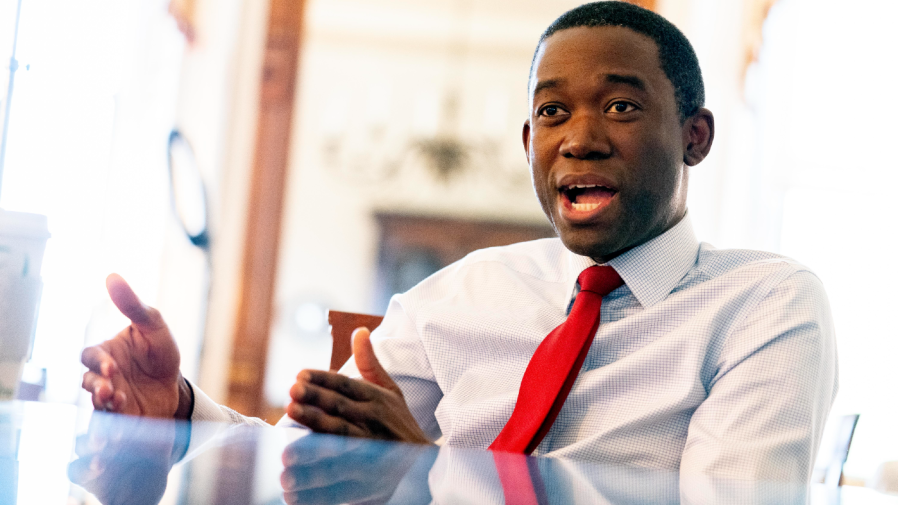
Deputy Treasury Secretary Wally Adeyemo speaks during an interview in his office at the Treasury Department in Washington, Tuesday, April 12, 2022. (AP Photo/Andrew Harnik)
The United States has gradually ramped up its military support for Ukraine. However, the Biden administration acted quickly with sanctions on Russia — and Deputy Treasury Secretary Wally Adeyemo has been leading those efforts from day one.
The United States started working with allies in November 2021 to prepare sanctions for a potential invasion, and President Biden announced the first round of sanctions on Feb. 22, 2022, hitting major Russian banks and imposing export controls on Russia.
In March, the US banned imports of Russian oil and sanctioned hundreds of Russian lawmakers, oligarchs, officials and state-owned companies.
Adeyamo, a veteran of the Obama administration, told the Washington Post in March that Russia’s economy would shrink, and the U.S. and its European allies would give Moscow a choice.
“The Kremlin can either continue their invasion, and if they do, we will continue to take actions with regard to sanctions or they can stop their invasion of Ukraine, and they can reinvest in their economy and invest in their people.”
A year later those efforts have shown mixed results, with signs of trouble for Russia’s economy, but the Kremlin doubling down on its war effort.
Adeyamo told Reuters last week that the U.S. would ramp up its focus on companies and individuals around the world helping Russia evade those sanctions — offering another choice between helping Russia or enjoying access to Western economies.
“For most of these companies, for most of these individuals, it’s a very easy choice,” Adeyemo said.
April — Victims of atrocities
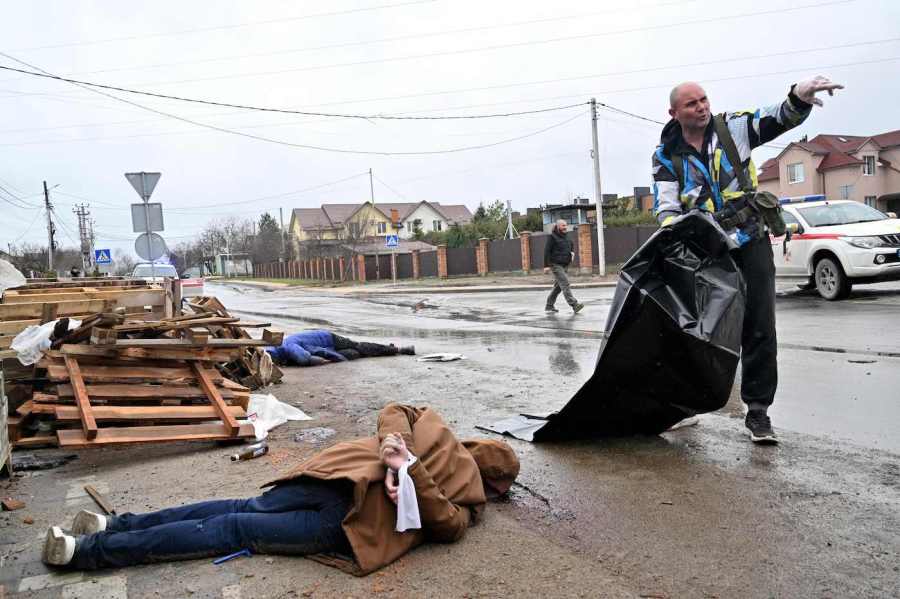
A civilian man with hands tied behind his back lies in the street as a communal worker prepares to carry him to a waiting car in town of Bucha, not far from the Ukrainian capital of Kyiv on April 3, 2022. (Photo by SERGEI SUPINSKY/AFP via Getty Images)
As Russian forces retreated from areas around Kyiv in early April, shocking images emerged that spurred global outrage over the atrocities being committed in Russian-occupied parts of Ukraine.
At the center of the horror was Bucha, a suburb of the capital that was home to some 36,000 people before the war.
Mass graves were discovered in the city, while bodies lined streets — investigators reported evidence of summary executions, enforced disappearances, and torture.
“Nearly every corner in Bucha is now a crime scene, and it felt like death was everywhere,” Richard Weir, a researcher at Human Rights Watch, said in April.
After months of painstaking investigations, officials said 458 bodies were recovered in Bucha, 419 of which bore markings of being shot.
The New York Times conducted a monthslong investigation into a rampage on one street in Bucha, showing the perpetrators were paratroopers from Russia’s 234th Air Assault Regiment led by Lt. Col. Artyom Gorodilov.
That contradicted claims by Russian President Vladimir Putin that the atrocities in Ukraine were a fabricated “provocation.”
May — Journalists
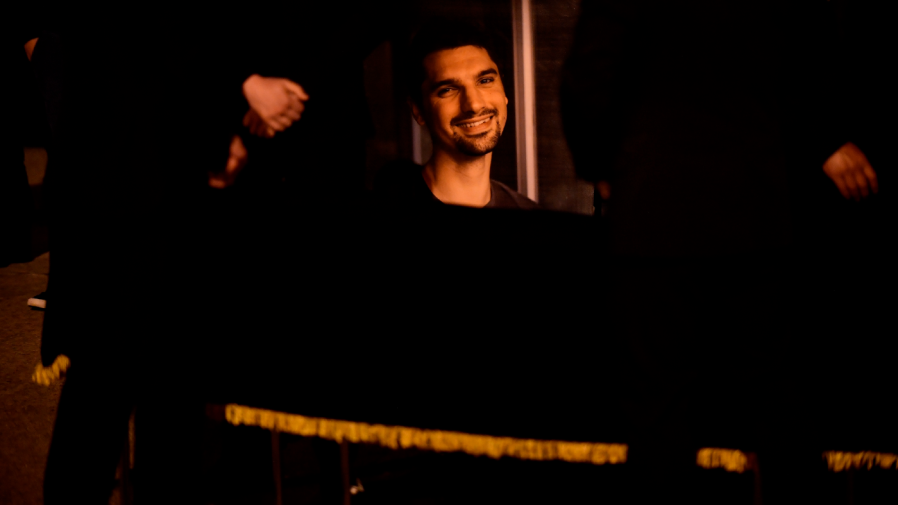
The coffin of French journalist of BFM TV news channel Frederic Leclerc-Imhoff, who was killed in Ukraine, is carried during a ceremony for the repatriation of his body at Le Bourget Airport, Thursday, June 9, 2022. (Julien de Rose, Pool via AP)
Frédéric Leclerc-Imhoff, a 32-year-old journalist covering the war for France’s BFMTV, was killed in late May after shrapnel pierced the armored vehicle he was traveling in while covering an evacuation in the eastern city of Severodonetsk.
French President Emmanuel Macron said Leclerc-Imhoff was in Ukraine to “show the reality of the war” and offered his “unconditional support” to journalists who “carry out the difficult mission of informing in theaters of operations.”
According to the International Federation of Journalists (IFJ), 12 journalists were killed in Ukraine in 2022 — making it the deadliest country in the world to be a journalist. Ukraine’s National Union of Journalists has listed 20 journalists killed during the war.
Most of those journalists were Ukrainians. A month before Leclerc-Imhoff was killed, Vira Hyrych, a journalist working for US-based Radio Liberty in Ukraine, was killed in a Russian missile attack on her apartment building in Kyiv.
“We are shocked and angered by the senseless nature of her death at home in a country and city she loved,” the outlet said. “Her memory will inspire our work in Ukraine and beyond for years to come.”
June — Magdalena Andersson and Sauli Niinistö
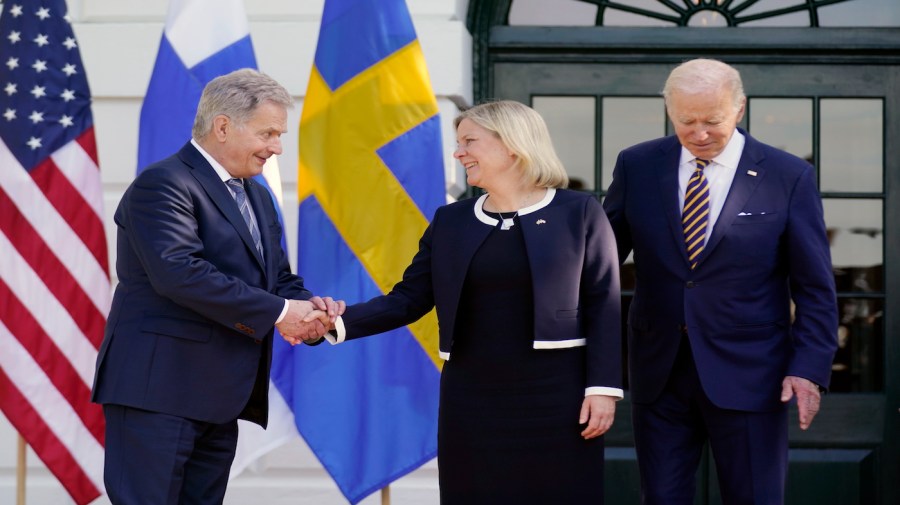
President Joe Biden greets Prime Minister Magdalena Andersson of Sweden and President Sauli Niinisto of Finland as they arrive at the White House in Washington, Thursday May 119, 2022. (AP Photo/Andrew Harnik)
One June 28, the leaders of Finland and Sweden met with Turkish President Recep Tayyip Erdoğan and announced a breakthrough in their bid to join NATO.
Turkey is still holding up the ascension, but the eventual expansion of the Atlantic security alliance would seem a fait accompli — and for Moscow an unwelcome consequence of its war on Ukraine.
The previous month, Prime Minister Magdalena Andersson of Sweden and President Sauli Niinisto of Finland visited President Biden at the White House to announce their intentions to join NATO.
That marked a stark shift in domestic opinion in those countries, where the public had long opposed full membership but quickly saw value in the additional security given their increasingly belligerent neighbor.
“And Russia’s full-scale aggression against a sovereign and democratic neighbor — that was a watershed moment for Sweden,” Andersson said from the Rose Garden. “And my government has come to the…conclusion that the security of the Swedish people will be best protected within the NATO Alliance.”
Putin issued a veiled warning over the expansion in June.
“If Finland and Sweden wish to, they can join. That’s up to them,” he said, but added “if military contingents and military infrastructure were deployed there, we would be obliged to respond symmetrically and raise the same threats for those territories where threats have arisen for us.”
July — Rep. Victoria Spartz
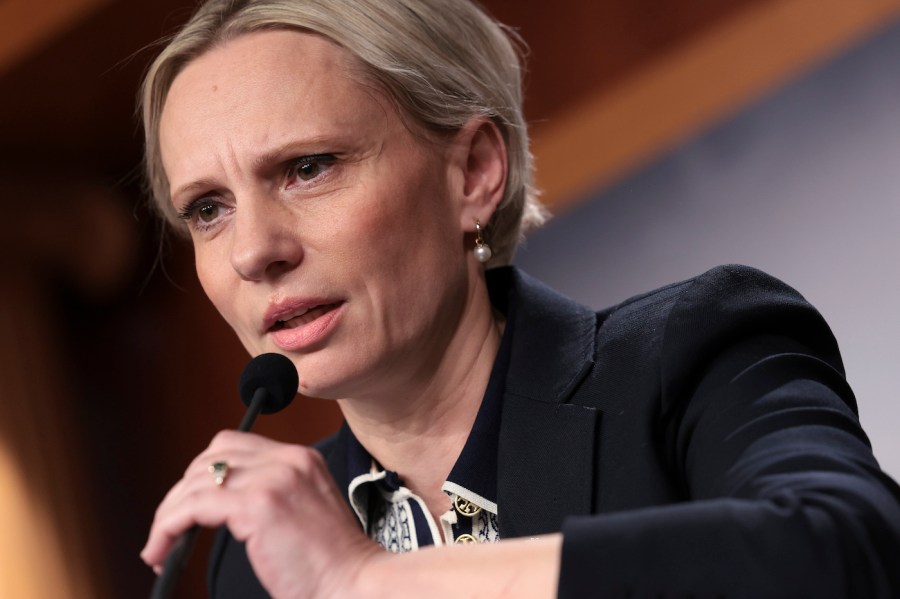
Ukrainian-American U.S. Rep. Victoria Spartz (R-IN) speaks at a news conference on Russia’s invasion of Ukraine at the U.S. Capitol on March 02, 2022 in Washington, DC. (Photo by Kevin Dietsch/Getty Images)
Rep. Victoria Spartz (R-Ind.) has emerged as a unique voice in Congress as the only Ukrainian-born member of the House.
Spartz has been a consistent supporter of U.S. support for Kyiv, but also a rare critic of President Volodymy Zelensky and his leadership amid the war.
“You even act like you don’t have a war!” Spartz said of Ukrainian leaders during an interview with Ukrainian radio in July.
Spartz was also among the first Republicans to call for increased oversight of US support for Kyiv, warning that Ukraine could become “another Afghanistan” without strong American leadership.
White U.S. aid to Ukraine continues to have strong bipartisan backing, there are signs that support is eroding — both within Congress and among U.S. voters.
House Speaker Kevin McCarthy (R-Calif.) has warned that Republicans will not write a “blank check” for Ukraine. And a recent AP poll found that 48 percent of Americans now favor sending arms to Ukraine, down from 60 percent last May.
Spartz announced earlier this month that she will not run for reelection.
August — Gen. Valery Zaluzhny

Commander-in-Chief of Ukraine’s Armed Forces Valeriy Zaluzhny pays his respects to victims of a deadly helicopter crash during a farewell ceremony in Kyiv, Ukraine, Saturday, Jan. 21, 2023. (AP Photo/Efrem Lukatsky)
In the first six months of the war, Ukraine shocked the world with its ability to withstand and repel Russia’s assaults.
In August, Ukraine’s military showed that it could take the offensive. In a series of operations launched in late August and early September, Ukraine’s military retook thousands of square kilometers of occupied land in the Kherson and Kharkiv regions and turned the tide of the war.
The head of the armed forces, Gen. Valery Zaluzhny, has become a national hero, nicknamed the “iron general.”
Zaluzhny has credited his success to trusting his generals and encouraging initiative within the military ranks — a contrast to the top-down approach that has dogged Russia’s military throughout the war.
In an interview with the Economist in December, he said his humanity distinguished him as a leader.
“To remain human, to become a leader. To be smarter, to be stronger, to be more talented and in that case try to manage people. That is a religion I practiced,” he said.
Zaluzhny has said that he expects Moscow to make another attempt to take Kyiv before the war is over, and repeatedly called for increased Western arms to push back Russian forces to pre-war lines.
“I know that I can beat this enemy. But I need resources,” he told the Economist.
Sept — Russian anti-war
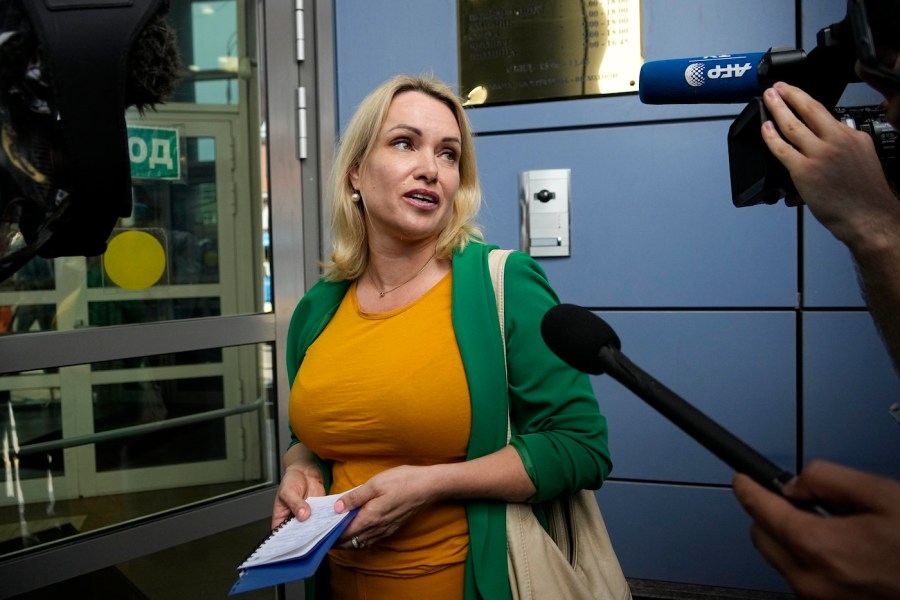
Marina Ovsyannikova, a former Russian state TV journalist who quit after making an on-air protest of Russia’s military operation in Ukraine, arrives for a hearing in a court in Moscow, Russia. (AP Photo/Alexander Zemlianichenko)
By all available metrics, support within Russia for Putin’s war remains high. However, pockets of discontent burst through after the Russian leaders announced the mass mobilization of military reservists in September.
Protests were reported in dozens of Russian cities, including Moscow and St. Petersberg, as well as in the Russian region of Dagestan, where minorities said they were targeted by the mobilization orders.
The United Nations reported that at least 2,377 demonstrators were arrested as authorities crushed the protests across the country.
And most of those who took to the streets were women.
Women accounted for 51 percent of 1,383 people arrested in the Sept. 21 anti-mobilisation protest and 71 percent of the 848 detained on Sept. 24, according to OVD-Info, a Russian group that monitors protests.
Within weeks of the war starting, Russia had criminalized anti-war protests and independent reporting on the war, with penalties of up to 15 years in prison.
One of the most prominent faces of Russian dissent is Marina Ovsyannikova, a state TV editor who interrupted a broadcast with an anti-war message in March 2022.
Ovsyannikova, who was fined and detained for her act of protest, fled Russia in October, according to her lawyer.
Oct — Sergiy Kyslytsya and Oksana Markarova
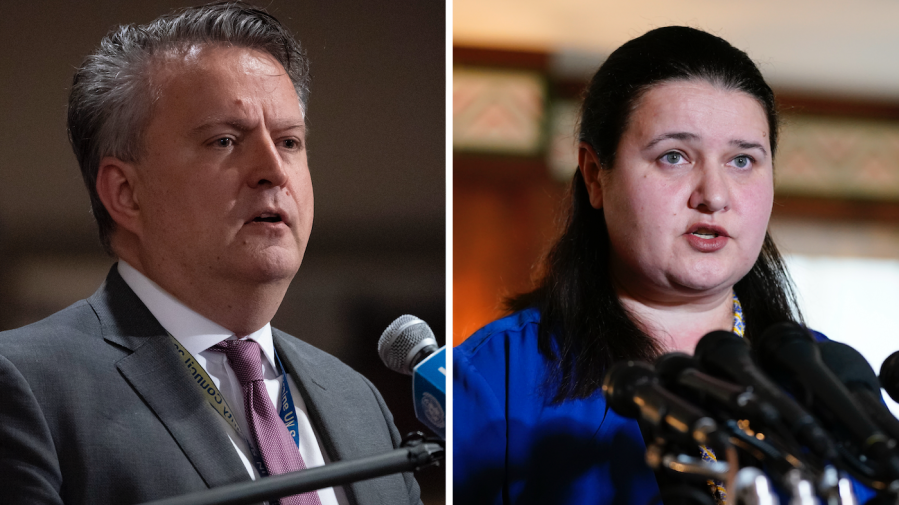
Sergiy Kyslytsya, Permanent Representative of Ukraine to the United Nations, and Ukraine’s Ambassador to the United States Oksana Markarova speak at separate press conferences. (AP Photo/John Minchillo/AP Photo/Patrick Semansky)
The international isolation of Russia amid its war was never more apparent than on Oct. 12, when the UN General Assembly passed a resolution demanding that Moscow reverse course on its “attempted illegal annexation” of four regions in Ukraine.
Only four countries joined Russia in opposing the resolution: Syria, North Korea, Belarus and Nicaragua.
It was a major victory for Ukraine and its ambassador to the United Nations, Sergiy Kyslytsya, who posted a photo of himself using binoculars shortly before the vote.
“Oh God! Can’t see it! How many you said voted for Russia? 4? Blimey!” he wrote.
Kyslytsya later told CBS News the vote was a “collective effort of an overwhelming majority, and the call of moral duty and reason.”
Ukraine’s ambassador to the U.S., Oksana Markarova, has also been a frequent voice for Ukraine on cable news and Sunday talk shows.
During President Biden’s State of the Union address earlier this month, Markarova was applauded during a rare moment of bipartisan unity.
“The Ukrainian ambassador to the United States is here tonight,” Biden said, as she raised her fist. “Let each of us here tonight in this chamber send an unmistakable signal to Ukraine and to the world.”
November — Civilian resistance (Kherson)
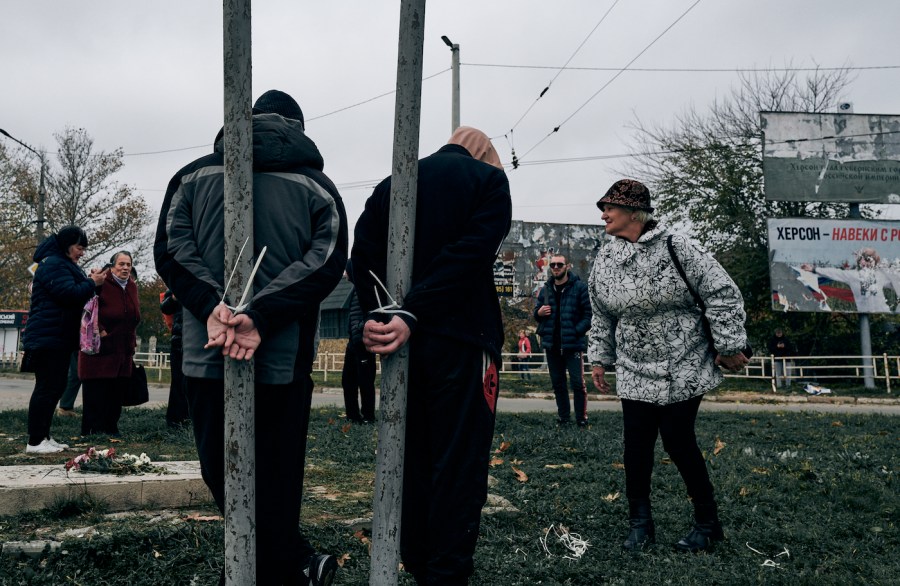
Local residents look at two alleged collaborators tied by the hands to pillars in Kherson, Ukraine, Sunday, Nov. 13, 2022. (AP Photo/LIBKOS)
Ukraine notched one of its biggest military victories with the retaking of Kherson in November, pushing Russian forces out of the southern city it had captured early in the war.
But the soldiers didn’t do it alone. A civilian resistance force of underground partisans had been cooperating with the military for months, funneling weapons to soldiers, sharing coordinates of Russian positions and killing Russian soldiers.
“I never questioned what we were doing,” Dmytro Yevminov, a yacht owner who hid guns and grenades in boatyards, told the New York Times. “I never knew I loved my country so much.”
“Before the war, my life was Instagram, coffee shops and trips to Kyiv,” Yulia, a 24-year-old who also joined the civilian resistance in Kherson, told the Guardian, describing herself as a soldier “just without the uniforms.”
Grassroots partisans risked arrest, torture or death if they were caught by occupying Russian forces, describing living in a heightened state of vigilance and fear.
Some provided intelligence to military handlers, while others took up arms. “Around the city, there were a lot of people with weapons who were waiting for the right time to use them,” a partisan named Ihor told the Washington Post.
The Institute for the Study of War has said Ukrainian partisan warfare is also being waged in occupied cities such as Melitopol, Mariupol and Donetsk.
December — Zelensky
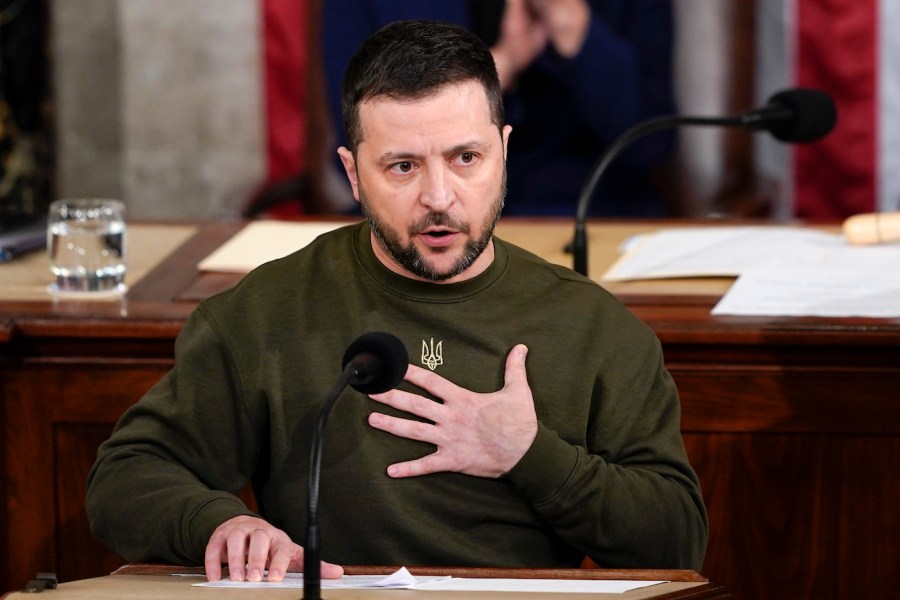
Ukrainian President Volodymyr Zelenskyy addresses a joint meeting of Congress on Capitol Hill in Washington, Wednesday, Dec. 21, 2022. (AP Photo/Carolyn Kaster)
Ukraine’s president Volodymyr Zelensky made his first trip outside Ukraine in December, visiting President Biden at the White House and delivering an emotional address to Congress.
The charismatic former comedian evoked laughter, applause and shouts of “Slava Ukraini,” returning time and again to his call for more weapons, including long-range missiles and air defense systems.
“If your patriots stop the rise in terror against our cities, it will let Ukrainian patriots work to the full to defend our freedom,” he said.
Zelensky, embodying the “spirit of Ukraine,” was named Time’s person of the year in 2022, with editor-in-chief Edward Felsenthal saying he “has really galvanized the world in a way we haven’t seen in decades.”
The Ukrainian leader’s latest battle cry has been a demand for modern fighter jets from the U.S. and Europe — a demand Biden has so far rejected.
However, Zelensky visited London earlier this month and secured a British commitment to start training Ukrainian pilots to fly NATO-standard fighter jets.
“Leaving the British Parliament two years ago, I thanked you for delicious English tea,” Zelensky told a packed Westminster hall. “I will be leaving the Parliament today thanking all of you in advance for powerful English planes.”
January — Ukrainian soldiers

A Ukrainian soldier in Bakhmut, Donetsk region, Ukraine, Monday, Feb. 20, 2023. (AP Photo/Libkos)
Throughout the winter, a grinding war of attrition played out around the eastern city of Bakhmut, which has become a symbol of Ukraine’s resilience, and Russia’s struggle to regain territory.
“Bakhmut is holding out against all odds. And although most of the city is destroyed by Russian strikes, our warriors repel constant attempts at Russian offensive there,” Zelensky said in a nightly address in early January.
Ukrainian officials have said Russia is losing up to 100 soldiers a day in its desperate efforts to take Bakhmut and claim a rare victory one year into the war.
Ukraine has also paid a high human price in Bakhmut and elsewhere. A top Zelensky adviser said in December that 10,000 to 13,000 Ukrainian soldiers have been killed in action.
Russia also launched a new wave of missile attacks on Ukraine’s energy infrastructure in January, and carried out one of its deadliest attacks of the war — a strike on an apartment building in the city of Dnipro that killed 45.
European Commission President Ursula von der Leyen said an image of a yellow kitchen in the bombed out building had become the “latest symbol” of Russia’s terror.
“One day, the room is filled with happiness. The day after, the family is no more,” she said.
Copyright 2024 Nexstar Media Inc. All rights reserved. This material may not be published, broadcast, rewritten, or redistributed..









